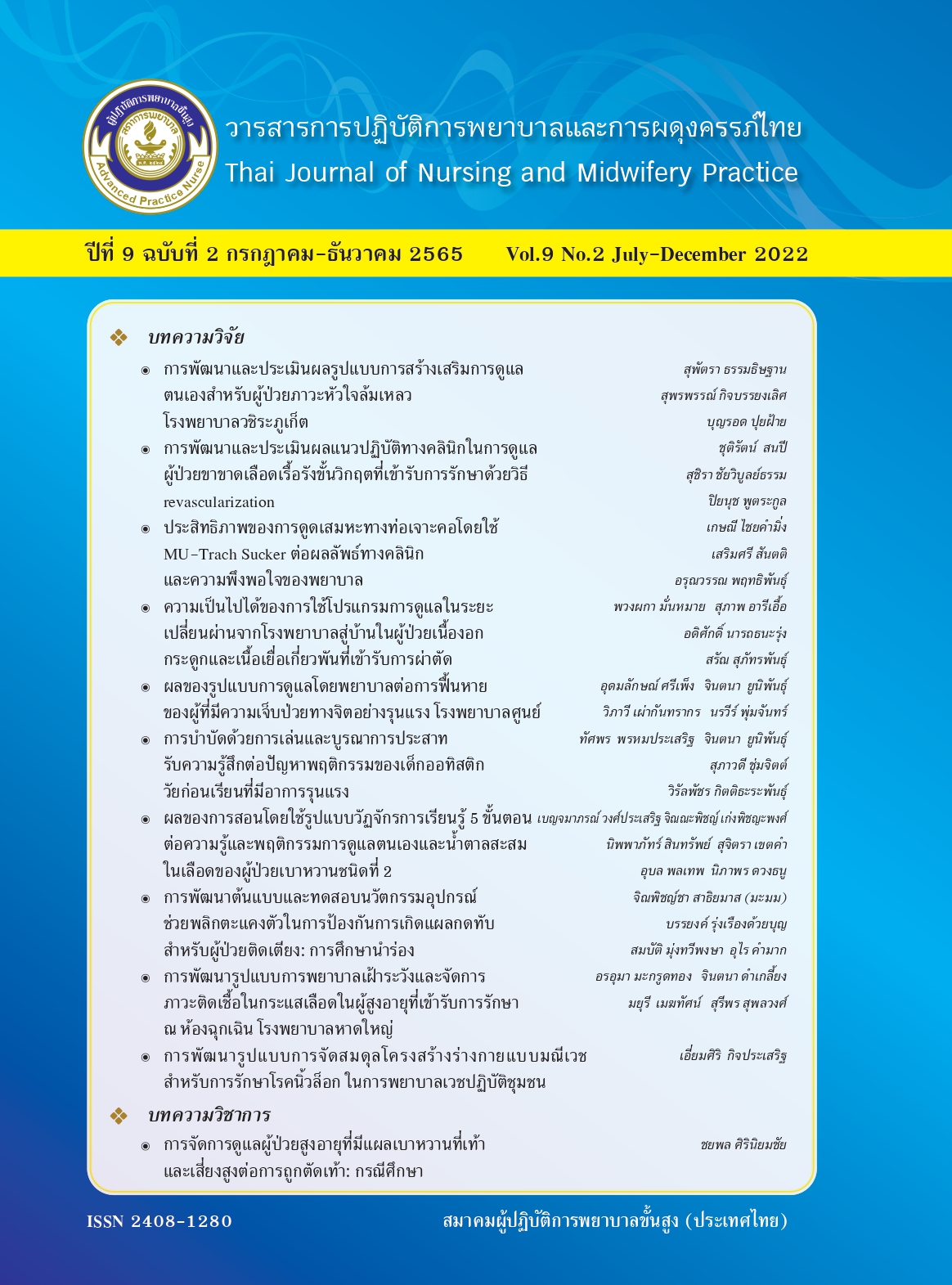Effectiveness of Tracheostomy Tube Suctioning Using Mu-Trach Sucker on Clinical Outcomes and Nurse’s Satisfaction
Main Article Content
Abstract
Tracheostomy tube suctioning in children, although it is necessary but wrong suction technique can also affect the patient. Quasi-experimental and a crossover research design was used to compare the effectiveness of tracheostomy tube suctioning using MU-Trach sucker and conventional suction catheter on tissue damage, amount of secretion, clinical outcomes and nurse’s satisfaction. The sample included 28 pediatric patients aged 1 month to 12 years old with tracheostomy tube, who having stable vital signs and conditions, not using mechanical ventilators and normal cough response. Simple random sampling was used to identify which method would be use first and later. When drawing lottery, method that was chosen first would be used to suction 3 times and would be spaced for at least 3 hours before using another. Data were collected on the amount of secretion, tissue damage and clinical outcomes based on the criteria. Data were analyzed using independent t-test and Wilcoxon Sigh-Rank test. The results revealed that even though using MU-Trach sucker yielded no difference in the amount of sputum but caused less tissue damage than conventional suction at statistical significance (p<.05). In addition, nurse’s satisfaction with equipment was at the highest level. Moreover, an average of changes in heart rate, period of time taken for the heart rate and oxygen saturation to return to average level when using MU-Trach sucker were less than those of conventional catheter were significantly less than those of conventional catheter (p<.05). In addition, nurse’s satisfaction with such equipment was at the highest level. The result showed that using MU-Trach sucker was safe and could be used for tracheostomy tube suction in children.
Downloads
Article Details

This work is licensed under a Creative Commons Attribution-NonCommercial-NoDerivatives 4.0 International License.
References
Campisi P, Forte V. Pediatric tracheostomy. Semin Pediatr Surg. 2016;25(3):191-5.
Preutthipan A, Kuptanon T, Kamalaporn H, Leejakpai A, Nugboon M, Wattanasirichaigoon D. Using non-invasive bi-level positive airway pressure ventilator via tracheostomy in children with congenital central hypoventilation syndrome: two case reports. J Med Case Rep. 2015; 9:149.
Funamura JL, Yuen S, Kawai K, Gergin O, Adil E, Rahbar R, et al. Characterizing mortality in pediatric tracheostomy patients. The Laryngoscope. 2017;127(7):1701-6.
Dal'Astra AP, Quirino AV, Caixeta JA, Avelino MA. Tracheostomy in childhood: review of the literature on complications and mortality over the last three decades. Braz J Otolaryngol. 2017;83(2):207-14.
Bunburaphong T. Temperature and humidity therapy: Respiratory care in clinical practice. 7nd ed. Bangkok: Panyamitr; 2017. (In Thai)
Kuptanon T. Airway management. In: Khositseth A., Preutthipan A., Leejakpai A., Khongkhatithum C., Pandee U., Lertbunrian R., editors. Pediatric critical care, The Thai Society of Pediatric Respiratory and Critical Care Medicine;2013. (In Thai).
Limprayoon K. Basic mechanical ventilation in pediatric. In: Kjornpredanont Y., editor. Medical equipment in critical care. 3rd. Bangkok: STC and Marketing Co., Ltd.; 2013; 2558. (In Thai).
Chantra M. Endotracheal tube care. In: Preutthipan A., Paoin V., Samransamruajkit R., Udomithiphong K., editor. Smart practice in common pediatric respiratory problem. Bangkok: Beyond enterprise company limited. 2013. (In Thai).
Couchman BA, Wetzig SM, Coyer FM, Wheeler MK. Nursing care of the mechanically ventilated patient: what does the evidence say? Part one. Intensive Critical Care Nursing, 2007;23(1):4-14.
Niyomwit K. Nursing care for reducing secretion retention in pediatric patient. Phrapokklao nursing college 2019;30(1): 216-225. (In Thai)
Janthira J.Nursing care of patients with hypoxemia. Nakhon Ratchasima : Suranaree University of Technology. 2017. (In Thai)
Utrarachkij J. Tracheostomy Tube Care: In: Preutthipan A., Paoin V., Samransamruajkit R., Udomithiphong K., editors. Smart practice in common pediatric respiratory problem. Bangkok: Beyond enterprise company limited. 2013. (In Thai).
McClean EB. Tracheal Suctioning in Children with Chronic Tracheostomies: A Pilot Study Applying Suction Both While Inserting and Removing the Catheter. J Pediatr Nurs. 2012;27(1):50-4.
Polit DF, Sherman RE. Statistical power in nursing research. Nurs Res. 1990;39(6):365-9.
Schults JA, Mitchell ML, Cooke M, Long DA, Ferguson A, Morrow B. Endotracheal suction interventions in mechanically ventilated children: An integrative review to inform evidence-based practice. Aust Crit Care. 2021;34(1):92-102.
Lawrence PR, Chambers R, Faulkner MS, Spratling R. Evidence-Based Care of Children with Tracheostomies: Hospitalization to Home Care. Rehabil Nurs. 2021;46(2):83-6.
Maggiore SM, Volpe C. Endotracheal suctioning in hypoxemic patients. Reanimation, 2011;20(1):12-18.
Thanjira S. Vascular disorder. In: Rimsrithong S., Thanjira S., Techashong A., Phatichak S., editors. Pathophysiology in nursing.4 th. Bangkok: Samchareon phanich CO., LTD: 2013. (In Thai)
Bassi GL. Airway secretions and suctioning. In: M. J. Tobin (Ed.), Principles and Practice of Mechanical Ventilation, 3th ed. New York, NY: The McGraw-Hill Companies. 2013.
Gillies D, Spence K. Deep versus shallow suction of endotracheal tubes in ventilated neonates and young infants. Cochrane Database Syst Rev. 2011;2011(7).
McClean EB. Tracheal suctioning in children with chronic tracheostomies: a pilot study applying suction both while inserting and removing the catheter. J Pediatr Nurs. 2012;27(1):50-4.
Irajpour A, Abbasinia M, Hoseini A, Kashefi P. Effects of shallow and deep endotracheal tube suctioning on cardiovascular indices in patients in intensive care units. Iran J Nurs Midwifery Res. 2014;19(4):366-70.
American Association for Respiratory Care. Endotracheal Suctioning of Mechanically Ventilated Patients with Artificial Airways 2010. RESPIRATORY CARE. 2010;55(6):758-764.
Abbasinia M, Irajpour A, Babaii A, Shamali M, Vahdatnezhad J. Comparison the effects of shallow and deep endotracheal tube suctioning on respiratory rate, arterial blood oxygen saturation and number of suctioning in patients hospitalized in the intensive care unit: a randomized controlled trial. J Caring Sci 2014;3(3):157-164.
Fiske E. Effective strategies to prepare infants and families for home tracheostomy care. Adv Neonatal Care. 2004;4(1):42-53.
Watters KF. Tracheostomy in Infants and Children. Respir Care. 2017;62(6):799-825.


